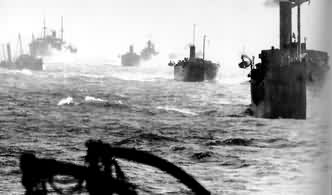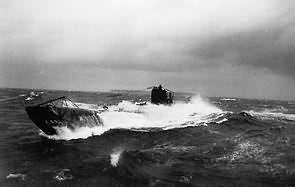
HMS Firedrake
|
Another slow moving convoy
by Donald J. L. Coombes |
|
During the second week of December 1942 the destroyer, H.M.S. Firedrake (1300 tons) left Londonderry to escort yet another slow moving convoy of merchant ships across the north Atlantic Ocean. The bad weather became steadily worse, building up to the worst storm in that area for some thirty years. |
 |
By
the afternoon of the 16th the sea was a heaving boiling mass as
far as the eye could see. Watching the convoy from Firedrakeís bridge
someone remarked of one of the smaller ships "Iím glad Iím not on
her" as the sea tossed both escort and merchant ships through fantastic
dances. The Firedrake was in no better straits, battling into a head sea and taking the gigantic waves in threes, riding the top of the first to plunge down to the base of the second, when the shipís buoyancy struggled against the massive weight of the water covering the foícísle to bring the bow half way up the third, whence it was carried to the crest, |
| only to plunge down and begin the whole process again. Men moving from one part of the ship to another would phone when leaving and again on arrival, such was the risk of being swept over board. |
| Following
the convoy was a pack of German U-boats bent on destroying as much
of the convoy as it could. Indeed a merchantship was lost every
night during the first four nights at sea. Apart from continuing
to battle with the elements and trying to keep clear of the seas
which were continually flooding the quarter deck knee high, the
first watch of the 16th (8pm till midnight) was passing uneventfully,
until at about 10pm there was a dull muffled thump. A quick look forward showed debris flying about in all directions from mid-ships on the starboard side, a torpedo having struck just aft of the break of the foícísle below the forward funnel, virtually the same spot that an Italian bomb had hit whilst in the Mediterranean sea. |
| I
watched as the bridge structure leant over to starboard and fell
into the sea, the whole fore part subsequently sinking in about
twenty or thirty minutes, but not before a signalman had attempted
to flash a message to the after part sitting astride the highest
point on the sinking part of the ship. We were powerless to help. Peering through binoculars into the darkness I saw, as a dark shadow, what appeared to be the U-boats conning tower, which gave rise to the hope that some of our chaps might have been picked up by the enemy, In the event only one man from the forepart survived. |
 |
|
Apparently the submarine U211 had surfaced for routine ventilation and battery charging and was surprised that her presence was not detected by our Asdic or radar. It is equally surprising that the sound of our propellers had not been heard, the fury of the weather obviously blotted out all other sounds. In order to lighten the ship our four torpedoes were fired and all depth-charges were made safe and dropped, and to attract the attention of the other escort vessels, we fired star shells. The first reaction from the escort group was to train the radar onto the position of the star shells, and picking up Firedrakeís after part on their screens, assumed that we were on station and in good order. After more star shells had been fired HMS Sunflower came over to investigate and sent up star shells of her own. The sound of those shells whistling over head caused us to fear that we were to be finished off by the U-boatís gun - not a happy moment! |
|
When "Sunflower" came as near alongside as she could get, it was decided to take survivors off by bosonís chair, but with the corvette at one point towering some sixty feet above us and the next sixty feet below in that mighty sea no such action was possible. It was decided therefor to wait for daybreak before transferring to the rescue ship. |
| Firedrake however began to settle lower in the water and was finally abandoned at about midnight, survivors taking to the rafts to make their way over to the Sunflower. Several men perished in the cold, some being in the water for two hours, during which time Sunflower continually sought out survivors with great skill and determination and courage, one of her crew actually going over the side to help men inboard. |
| I was one of the last to leave Firedrake and a group of us floated across in a raft, most of whom were picked up quite quickly. I was at the bottom of the scrambling net when a wave swept over us, followed by a second and then a third, which washed me away. Perhaps one of the more frightening moments came when the sea lifted the Sunflowers bows clear of the water and we were drawn directly under the peak which then began to descend on us. The lowering ship however displaced the water and we were swept clear. The second time it was not so frightening. |
 |
| Eventually twenty seven out of the crew of 194 were rescued, one of whom died before day break and was buried at sea. Whilst at one point swimming alone in the sea it occurred to me that I might shortly be face to face with my Maker and in that moment I seemed to have an assurance that I would survive. I well remember stepping bare foot onto Sunflowers deck, the little ship being flung about by wind and sea, and feeling as if I had stepped onto solid rock. |
| Asked
recently how I felt at the time losing so many people with whom
I had served I had to say that it hurts more now than it did then.
It all happened nearly sixty years ago now but there are moments
when it could have been only last night. Karl-Heinz Schmidt-Rosemann,
possibly the only survivor of U211, which was sunk by the RAF some
eighteen months later wrote recently about this event "I hope never
again". So do we all. "Yea, though I walk through the valley of
the shadow of death I will fear no evil, for thou art with me". Donald J.L. Coombes. Survivor HMS Firedrake 17.12.42 |
|
While
on survivors leave in January 1943, Donald learnt that the convoy
had been shadowed by a wolf pack of 13 U-boats. In
another report Firedrake, had picked up a U-boat contact and had
been tracking it since about 5pm thatís why Firedrake was 5 mile
south of the convoy. |
|
Announcement
|
| The association is very proud to announce that Donald Coombes has been made a Fellow of the Academy of " St Cecilia " which is devoted to the study and performance of music, in recognition of his excellent contribution to choral and church music. |
|
Other
Pages Below
|